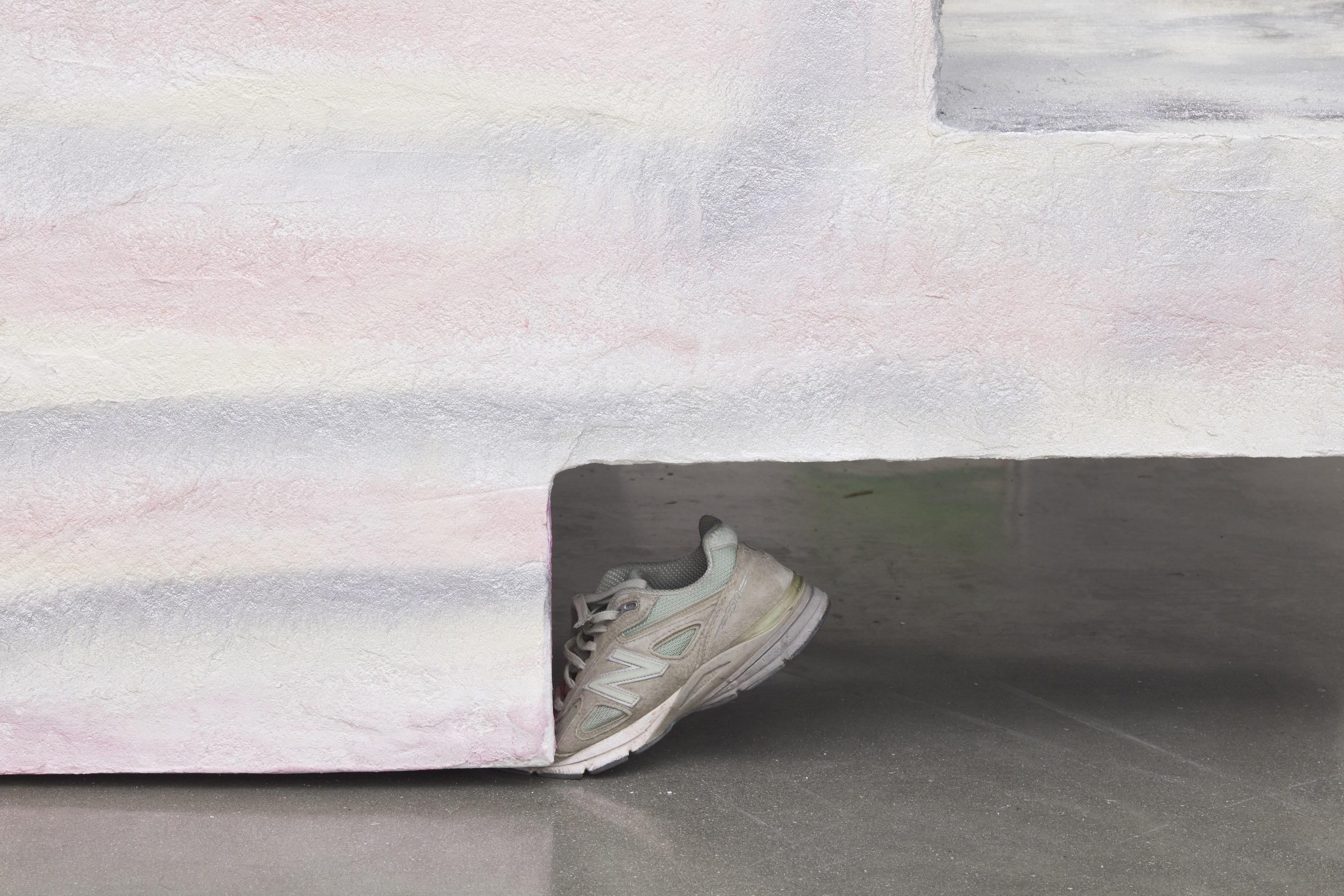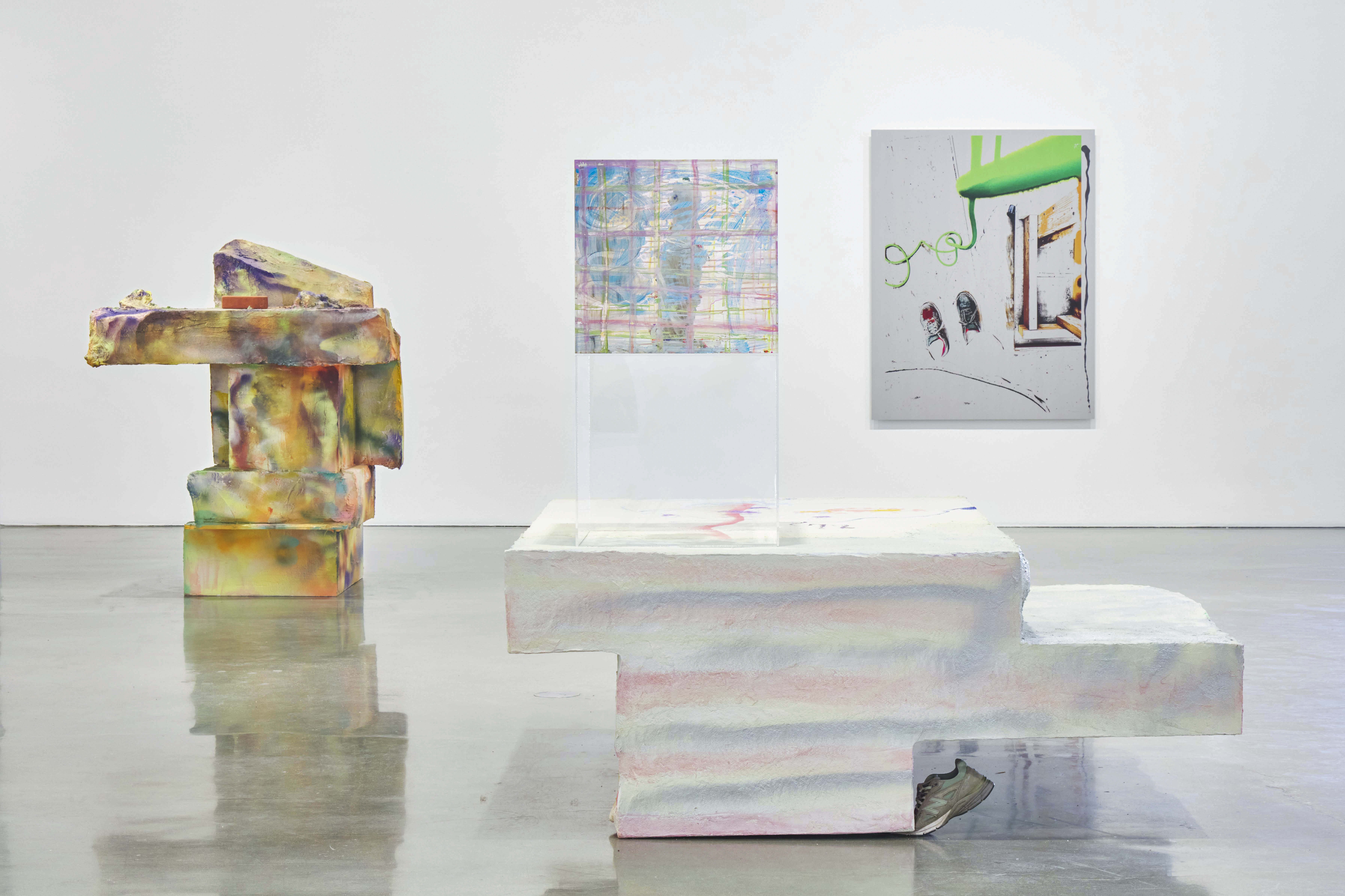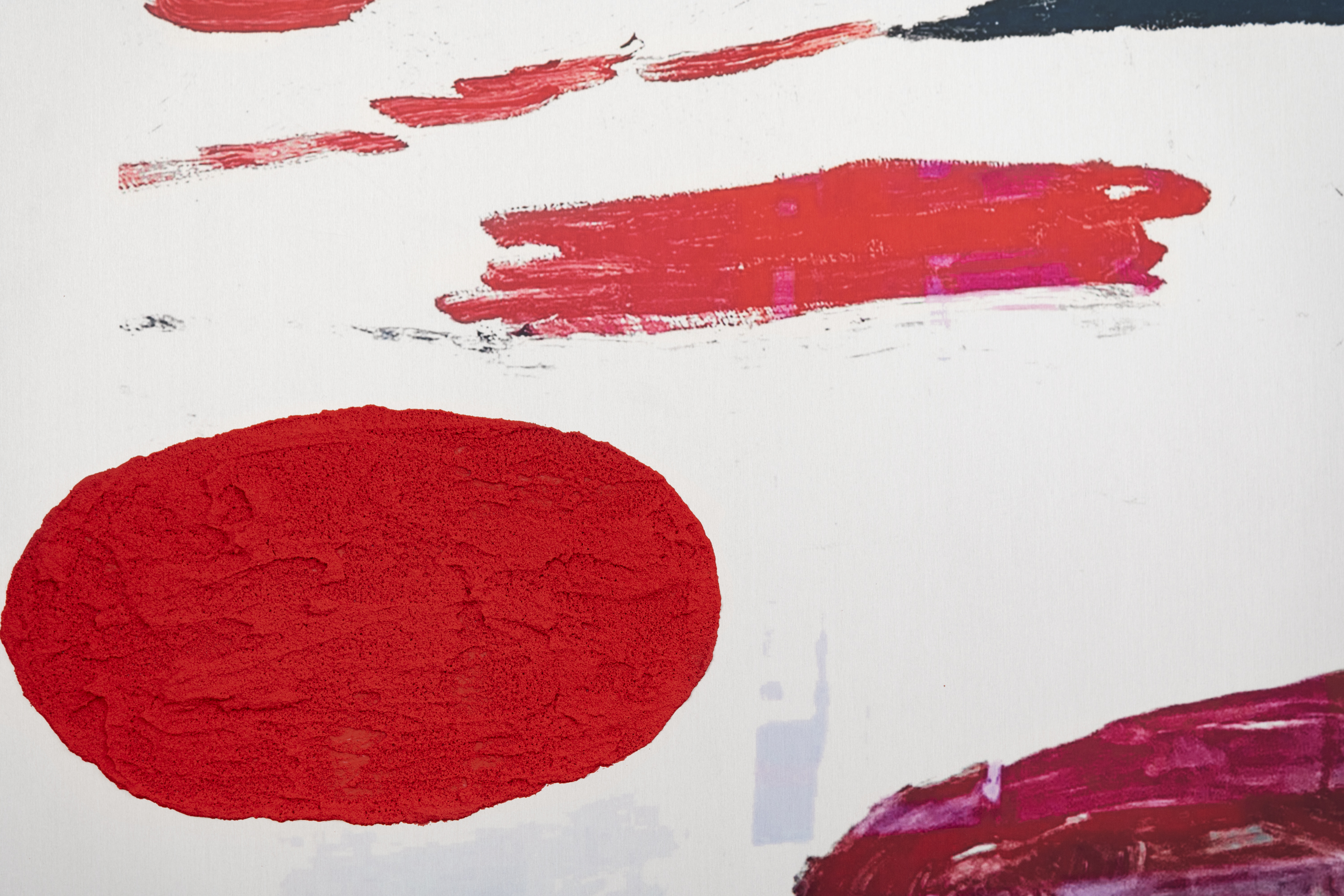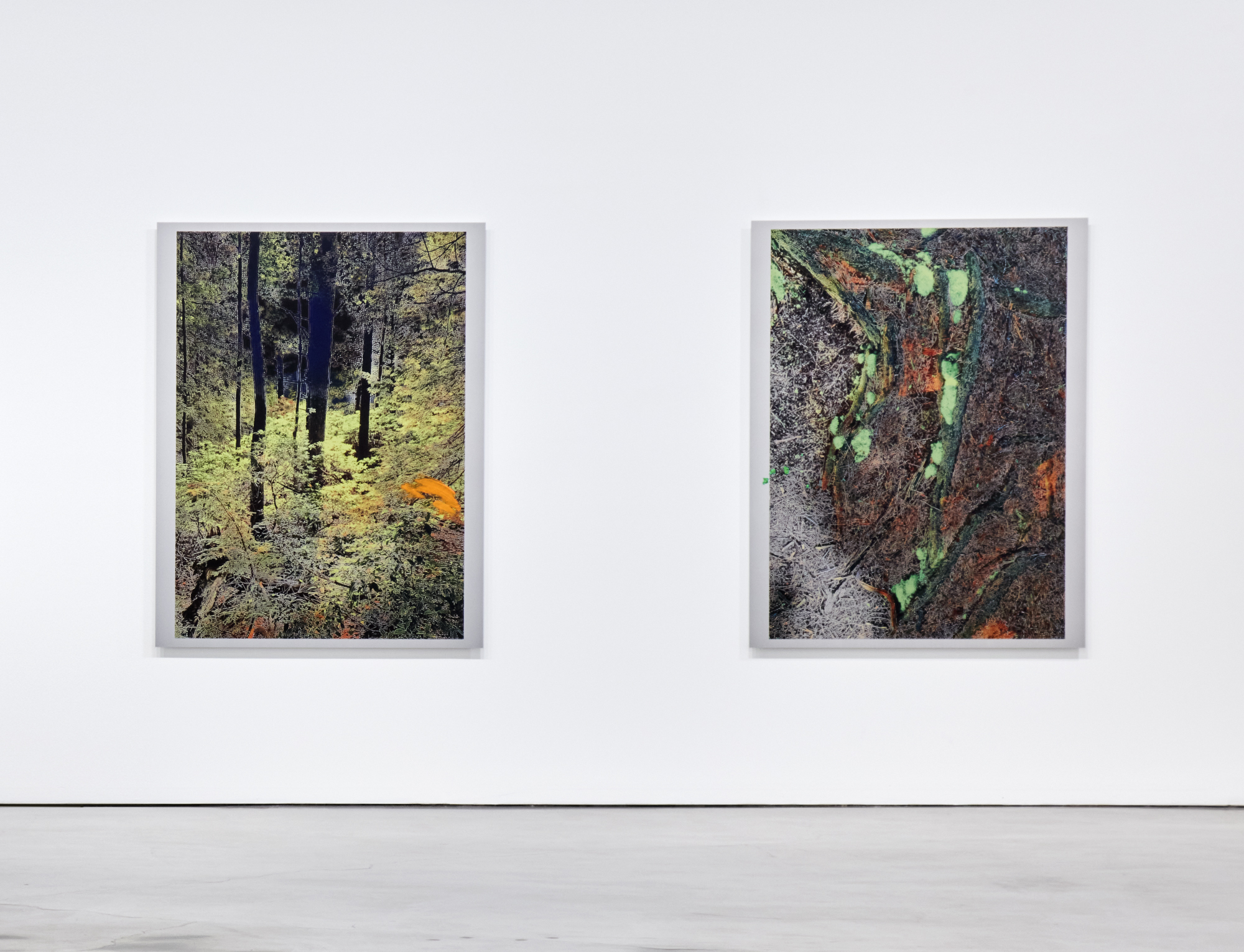Rachel Harrison’s solo exhibition at Regen Projects, Caution Kneeling Bus, on view January 15–February 20, 2022, presented new paintings and sculptures that upend an already precarious sense of reality. Aluminum paintings, familiar objects, and peculiar forms conversated in a language entirely their own. Harrison deftly conducted this cacophonous arrangement between signs for things (rather than things themselves), resulting in a show of bright eloquence that affirmed the visual and defied any easy assimilation into language qua consumable idea. What follows is a conversation between Harrison and Emma Kemp, with notes by the interviewer.

Rachel Harrison, Venus, 2021. Detail. Wood, polystyrene, plexiglass, acrylic, enamel, Venus statue, and pair of New Balance 990 shoes, 63 ½ x 69 x 69 in. © Rachel Harrison. Courtesy of the artist and Regen Projects. Photo: Evan Bedford.
EMMA KEMP: It is complicated, Rachel, this trying to talk with you about your show. The complication has to do with the work’s untranslatability. Or its indigestible conveyance. Or its narrative withholding. Or its sheer brutal presence as supralinguistic.
RACHEL HARRISON: I’m not sure what you mean by “supralinguistic,” I’ve never heard that term. But you are a writer and I’m not, which could be an interesting place to start. Labeling genres and mediums is such a natural tendency, as a way to get one’s head around things when they’re new—but this is also something I’m happy for my work to avoid. I’ve read people who write that my work “resists categorization” and thought, why not say it escapes categorization instead?
EK (note): Ursula Le Guin: “The direction of escape is toward freedom.” George Lakoff maintained that there is no system more basic nor fundamental to our structuring of reality than the concept of categorization. When a thought flees a common category, it moves to the realm of the imaginative abstract. It levitates. Harrison’s work—and I think this is important—orchestrates an exodus from accepted categorization by a process of intentional and conflictual layering. Juxtaposition isn’t quite the right word. It’s more like a velocity of difference that overwhelms reason. Haywire. Short circuit. Spinning rainbow wheel. Here are works rendered uncodable in the marketplace of reality.
RH: To return to the idea of translation, it makes me wonder what exactly you would want to translate an artwork into? You don’t want a novel, because then you would read Henry James. And you don’t want journalism, because then you would just read a good piece of reporting; a text that argues for something. Ultimately my work remains in a language of art, which some people believe is formalism. And it is, only in the best sense: in that content always needs a form, there’s no possibility of separation.
EK (note): Content without form is what? A thought, unuttered? Anne Carson describes Homer’s untranslatable MOLY as a word that stops itself. A full stop. I’m thinking that what is withheld makes space for contemplation. A woman guards her secrets like morsels of meat.

Installation view, Rachel Harrison, Caution Kneeling Bus, Regen Projects, Los Angeles, January 15–February 20, 2022. Left to right: Rachel Harrison, Cigar, 2021. Dye sublimation print, Flashe, and coarse pumice acrylic gel on aluminum, 62 x 47 ⅞ in. Medicine Ball, 2021. Detail. Wood, polystyrene, cement, acrylic, and 9-pound medicine ball, 55 x 55 x 48 in. Courtesy of Regen Projects. Photo: Evan Bedford.
EK: I liked immediately the title of the exhibition, Caution Kneeling Bus. An exclamation, it screeches to a halt. A warning, it hisses groundward by way of wheezing hydraulics. The majority of the works in the show have concise, one-word titles that jam the machinery of meaning, so at odds are they with the complexity of the total work—the total work being crystalline (not mystifying) yet maddeningly unclear. If the work has a message, it remains under wraps. It deals in its own secret handshake.
EK (note): What I’ve come to respect about Harrison’s work in this show is that it intercepts our correspondences with things in the external world; stretching the limits of the system through which meaning occurs. It begs a connection, a chain of commonality to link three distinct words. Then all of a sudden, we’re alone in the empty with what one writer described, quite deafeningly, as “the whir of thinking.”
RH: Why would we want an artwork to be clear, or supply a tidy summation of what it is? The experience of an artwork can be expansive, evolving and never complete. I try to go back to the Norton Simon Museum when I’m in LA to see Rubens’s Holy Women at the Sepulchre (c. 1611-14). Every time I see it I have a new experience.

Installation view, Rachel Harrison, Caution Kneeling Bus, Regen Projects, Los Angeles, January 15–February 20, 2022. Courtesy of Regen Projects. Photo: Evan Bedford.
EK: When I walked into your exhibition, I was struck by the presence of the wall pieces. At first, I felt an astringent aloneness as I scaled the edges of the room. I felt intimidated, that I was omega prey wandering at world’s end. At the same time, I had the thought that, if and when the world ends, I hope it ends like this, bright and pop-y and trashy, hot and cold, radioactive, humming. About the wall paintings—are they paintings? What do you call them?
RH: I use paint, so they’re paintings. Let’s call them paintings.
EK: They have an infrared, thermal-imaging quality to them, recognizable yet incoherent.
EK (note): I like stubborn work that holds on to its secrets. Stubborn in this sense is another word for woman.
RH: Could we say they are destabilized?
EK (note): The images have been destabilized through a process of technological rendering. The paintings are categorically unstable. I am curious about their half-life.

Rachel Harrison, Cigar, 2021. Detail. Dye sublimation print, Flashe, and coarse pumice acrylic gel on aluminum, 62 x 47 ⅞ in. © Rachel Harrison. Courtesy of the artist and Regen Projects. Photo: Evan Bedford.
EK: On certain nights, exhausted, I fall asleep on my MacBook. The device is warm on my lap when I’m writing and cold on my face when I wake. The cool aluminum of my laptop and the smooth black glass of my phone screen are probably the materials I touch most often. In your paintings, an overlay of paint assumes an animal quality, a forensic dimension pressing up against a cold, sterile surface. How did you arrive at the decision to print on aluminum?
RH: I wanted to print the files on something industrial that has a neutralizing effect. It’s more associated with signage than with art. After I made these, I went to see the absolutely brilliant Louise Lawler show at Metro Pictures, of long exposures taken in Donald Judd’s show at MoMA after dark using only the ambient light. I was surprised to learn that she was using the same printing process on the same surface, dye sublimation prints on aluminum. The results are quite different, though, because I’m using the material in the wrong direction, with the grain of the metal running vertically. It doesn’t reflect light in the same way. Maybe the works appear a bit cold and removed, less photographic.
EK: This incongruity, intentional misuse. Another rupture in a chain of transferences.
RH: There’s something off. Like how the world feels these days. Anyway, to go back to your question of titles, my titles in this exhibition are direct descriptions of objects, nothing more—no poetry.
EK (note): The titles are categories. Boxes of dynamite. This work demands a tolerance for difficulty.

Installation view, Rachel Harrison, Caution Kneeling Bus, Regen Projects, Los Angeles, January 15–February 20, 2022. Left to right: Rachel Harrison, Trees, 2021. Dye sublimation print and Flashe on aluminum, 62 x 47 ⅞ in. Moss, 2021. Dye sublimation print and Flashe on aluminum 62 x 47 ⅞ in. Courtesy of Regen Projects. Photo: Evan Bedford.
EK: Trees and Moss are two of my favorite paintings. I contemplated them for a long time. In the context of the pandemic and sustained climate crises, these images stage a present and future loss. An encounter with losing.
RH: When you said you were scaling the perimeter, that was interesting to hear. I always sequence my pictures with a visual syntax, there is an intended order.
EK (note): The whir of thinking is our body learning to read the work.
EK: About Medicine Ball (2021), a hunk of green something in the main room of the gallery. The piece looks to me like a huge block of florist foam, a material both brittle and crumbly, enlarged to majestic proportions. I couldn’t help but read this sculpture in direct relation to its adjacent painting, Cigar (2021), a partial scan of Philip Guston’s Scared Stiff (1970). The painted overlay on your Cigar has a different texture to the others, it’s painted with coarse pumice. The two works seem perceptively, though not actually, materially connected. How do you consider the relationships between the wall paintings and the sculptures in the show?
RH: I add the paint each picture needs. With that one I felt the added paint should define itself as an object, to be more sculptural, to differentiate itself from the enlarged Guston brush strokes in the underlying image. It’s an oval. It has an irregular surface. It’s not smooth. It’s an object, a nameable shape. It has no brushstrokes and looks like more than just paint, which it is. The color is heavily pigmented, which is why the red is so strong. Putting the show together I knew I wanted this painting installed in line with the Medicine Ball sculpture, so that you could view them simultaneously in one field of vision.
EK: Shall we talk about Hot Topic #2?
RH: Well… do we need to? x

Rachel Harrison is an artist living and working in New York. Later this year, she will open a solo exhibition at the Astrup Fearnley Museet in Oslo, following a mid-career survey at the Whitney Museum of American Art (2019–20). Her work has been the subject of numerous solo exhibitions and catalogs and is represented in public collections in the US and abroad.
Emma Kemp is a writer and artist based in Los Angeles, where she teaches at Otis College of Art and Design.